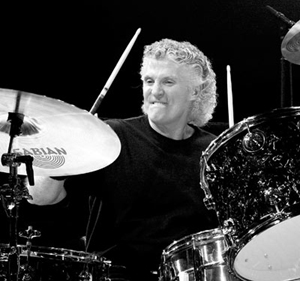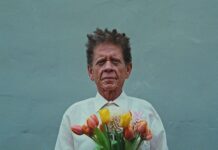By Shawn Perry
The last time I talked with Don Brewer, he was getting ready to step onto a Las Vegas stage with a new version of Grand Funk Railroad. Convincingly enthused about the revised lineup he and bassist Mel Schacher were leading, the drummer was realistic enough to know that Grand Funk’s days as an arena-fillin’ hit machine were a distant memory. Brewer beamed glowingly about the legacy of the band despite the somewhat acrimonious parting of the ways with guitarist Mark Farner in 1998. The important thing, he reminded me, was the music. A year later, the music of Grand Funk Railroad finally received the type of red carpet recognition it had so longingly deserved: a full-blown reissue campaign of their entire catalog.
As one of the biggest selling acts for Capitol Records, Grand Funk Railroad merited nothing less than top-notch and strategic promotion. For a group that hadn’t had a hit in over 25 years, the response was overwhelming. Phase one began in the summer of 2002 with the release of Live: The 1971 Tour, a collection of unreleased live tracks.
Two months later, remastered and expanded versions of the first four albums were rolled out — On Time (1969), Grand Funk (1969), Closer To Home (1970) and Live Album (1970). Phase two kicked into gear that fall with pristine reissues of Survival (1971), E Plurbis Funk (1971), Phoenix (1972) and We’re An American Band (1973). Finally, the third phase exploded in 2003 with the final four albums Grand Funk recorded for Capitol — Shinin’ On’ (1974), All The Girls In The World Beware!!! (1974), Caught In The Act (1975) and Born To Die (1976).
We’re talking about crispier sound, bonus tracks by the boatload, and some impressive repackaging with the option of collectively bundling the whole kit and caboodle under the hood of a novelty box called Trunk Of Funk. The idea is to purchase the entire catalog and fill the trunk. Yesiree, they’ve pretty much got this one covered. And no one could be more thoroughly pleased with the process than Brewer himself.
“I’m extremely happy with the way it’s gone,” he tells me via telephone from his home in Florida. “I’m really happy that they finally did it, to be honest.” The lanky and legendary drummer unloads a long-winded laugh before continuing. “They followed through and they let David Tedds (the producer of the GFR reissues) oversee the whole thing. David really understands the Grand Funk story; he made sure things were done right — rather than having some guy in the art department say, ‘Gee, Grand Funk Railroad…who are they?’”
While the first eight albums provide a clear glimpse into Grand Funk’s development, my goal of this exchange was to talk with Brewer about the band’s final four albums, recorded during the band’s apex and eventual fall from grace. I began by asking how the members of Grand Funk prepared to follow up We’re An American Band, their biggest hit up to that time.
“Well, we didn’t,” he admits. “It shocked us as much as it shocked the critics to come out with We’re An American Band and have it become such a strong record. When we went into the studio to start working on the next record (Shinin’ On), I think it was kind of a hurried process. ‘Oh my God, we got to come up with a follow-up.’ So, we went in and kept Todd Rundgren on as the producer.”
Recorded at the Swamp, the band’s own studio on Farner’s farm, Shinin’ On was built from the ground up with a keen eye on the singles charts. With Grand Funk flying high again, it was important to maintain the momentum by flooding the market with radio-friendly fodder. Brewer says some last minute decisions altered the original plan.
“We had finished the record really and “Shinin’ On” (the second consecutive Brewer composition that doubles as a GFR album title) was gonna be the single. We listened to it and thought it wasn’t strong enough to be a follow-up single to “We’re An American Band” or “Walk Like A Man,” which were both Top 20 hits. We felt we needed another song and that’s when ‘The Loco-motion’ kind of popped up. We all thought, ‘What a great kind of a parody — Grand Funk Railroad doing ‘The Loco-motion’.’ We knew that would be a hit. It kinda pulled the album up to where it should be.”
For the record, GFR’s take on “The Loco-Motion” zoomed to the top of the charts, marking the first time that an original and a cover version both reached Number One status on the Billboard Hot 100.
Rounded out by snappy little rockers like “To Get Back In” and “Little Johnny Hooker,” Shinin’ On got a big push upon its release. To a lot of fans, Grand Funk was a completely different band, no longer the gritty power trio of 1970. In Brewer’s words, “FM underground was no longer FM underground. It was now hit radio.” And Grand Funk Railroad was smack dab in the middle — a certifiable pop act. The drummer offers, without apology, that the hype surrounding the album was, “a bit too much. We were listening to people and they were telling us what we should do. And it probably wasn’t what we should have done, but we did it any way.”
In retrospect, can it be said that the album didn’t live up to the hype? “Not to demean the music of Shinin’ On,” Brewer says. “But we just didn’t prepare long enough. I think it’s a good album, but I don’t think it has the cohesiveness of We’re An American Band. The songs didn’t stick together quite as well.”
To sort of simmer the buzz, Shinin’ On was the last album Grand Funk would make with Todd Rundgren. Brewer acknowledges that the decision wasn’t unanimous. “I would have liked to have made more records with Todd, but I think the powers that be said it was time to change.”
And what a change there was. But was it in the right direction? Truth be told, All The Girls In The World Beware!!! is oozing with even more commercial pizzazz than its predecessor. To many of the band’s longtime supporters, this rampant desire to please the masses was killing the spirit of Grand Funk. The album certainly lacks that unique edge associated with the GFR sound.
“We changed producers and went with Jimmy Ienner,” Brewer explains straight away. “Jimmy was a great producer. He’s just not a rock producer like Todd. Where he Todd could achieve that huge rock sound, Jimmy is more of an old school, R&B producer.”
Considering the fact that much of Grand Funk’s roots were steeped heavily in R&B, the match wasn’t a complete wash. Brewer recalls how, in their beginnings, the band “took an R&B formula and converted that over to the hard rock kind of scenario with three pieces.”
With Ienner on board, Brewer says and the band began work on All The Girls In The World Beware!!!, and could “feel the disco influence coming. There were groups like the Bee Gees happening, so we were going, ‘Uh oh, here comes another change in radio,’” he laughs before clearing the record. “We didn’t want to go that disco route — forget that. We went back to our roots with more of an R&B sound.”
Brewer and keyboardist Craig Frost were writing a lot more of the songs, Farner cut his trademark mane of hair, and the album cover featured each band member’s head superimposed onto the body of either Franco Columbo or Arnold Schwartzenegger. Needless to say, things in the GFR camp were getting a bit…camp. “It was a tumultuous time in the band as well as outside of the band,” Brewer confesses. “A lot of things going on were affecting what we were doing. That all shows up on records.”
Nevertheless, the hits from All The Girls In The World Beware!!! have stood the test of time. The remake of the Soul Brothers Six hit “Some Kind Of Wonderful” was a long time coming. According to Brewer, the song was in regular rotation during the band’s pre-show preparation. “We’d go on tour and travel from the hotel over to the venue to play a show. ‘Some Kind Of Wonderful’ was kind of a warm-up thing we’d do in the back of the car, just a cappella. I’d start singing, ‘I don’t need a whole lots of money,’ and everyone would start clapping and we’d all sing the choruses together, ‘Some kind of wonderful…’ The manager that we had, Andy Cavaliere, said, ‘Man, why don’t you guys cut that. That would be great.’ So we got the original version on a 45 and kind of copped the feel of what those guys did, but brought it up to date in the 70s and made it our own. It was a huge hit.”
The other hit was “Bad Time,” a saucy Mark Farner original and, as Brewer so eloquently puts it, “a major, major departure for Grand Funk Railroad. Still to this day, a lot of people don’t think that’s a Grand Funk song,” he says, quickly adding, “it’s very pop, surgery, sweet, syrupy. But I think it’s a great hit pop song.” It would also be the last one for the veteran band from Flint, Michigan. Even with their success unabated and in full stride, the internal chemistry between the members of Grand Funk Railroad was starting to erode. As the band struggled with where to go next, Capitol seized the downtime by exploiting one of the great, untapped resources in the GFR arsenal — their distinction as a live band.
Caught In The Act, Grand Funk’s second “live’ album, was most definitely a ray of hope for the group’s fans, young and old. As clean and polished as fine china, the album nonetheless exuded a punch and definition that had been missing from GFR’s recent studio efforts. Rock solid versions of “Footstompin’ Music,” “I’m Your Captain,” “Heartbreaker” and “Inside Looking Out” would reign in the old-timers, while pumped-up renditions of the band’s newer hits would draw in the rookies. And how does Brewer rate it alongside the previous live album from 1970?
“To be honest with you, I still like the raw energy of the first live album. With Caught In The Act, we had grown as musicians, but we were kind of doing what everybody else was doing at that time where you could go back into the studio and fix things. Whereas on the first live album, that is what it is. There’s no fixing going on there. That’s what the band sounded like.”
One of the more novel anecdotes involving Caught In The Act has to do with its previous incarnation as one of the few Grand Funk CDs released in the 80s. As was common in the early days of CD processing, Capitol couldn’t fit the original two-record set onto a single disc. Instead of issuing it as a double CD, it was decided that various sections of Caught In The Act would be deleted. Notably absent was Brewer’s showcase drum solo on “T.N.U.C.” Although it has since been fully restored on the reissue, the drummer is still amused by the edit.
“The thing that is strange to me is that ‘T.N.U.C.’ was never really meant to be a song; it was the vehicle for the drum solo. We figured, ‘We don’t just want to go out on stage and have Don start into a drum solo, so let’s set up a song around the drum solo.’ Somebody at Capitol must have said, ‘Oh ‘T.N.U.C.’ is a song, we’ll just leave that on and we’ll cut this drum solo out.’”
Unfortunately, the energy and drive behind Caught In The Act couldn’t save Grand Funk from imploding. In a last ditch effort to resuscitate the band, they recorded their final studio album for Capitol, the prophetically titled Born To Die. I asked Brewer what the state of GFR was at that time.
“Awful!” he answers with a cautious chuckle. “There was a lot of vibes going around. People were unhappy with things. It really was reflected in what we were doing. I think we were kind of going through the motions.”
In spite of its demeanor, Born To Die is a surprisingly sophisticated album. While somewhat mellow by Funk standards, it presents itself as a natural and mature progression. And though it failed commercially, some of Grand Funk’s most realized work is found in the grooves of Born To Die. Even in light of throwaways like “Sally,” other tracks like “Dues,” “Genevieve,” “Love Is Dyin’” and “Politician” — as modern and accessible as they sounded then — all resonate with some of that old GFR spark. For Brewer, however, the record was…well:
“I kind of look at records from what I was feeling at the time. I can look at the cover of On Time and I can feel what we were like in the studio at that time and go, ‘That was fun.’ Grand Funk — that was a good album because we felt good about being a band. Closer To Home — we were experimenting a little bit, going off deeper into our R&B roots, bringing in the girls to sing, and the orchestra for “I’m Your Captain.”
“Survival — that was a little up and down when we were in the studio, you know, ‘What are we doing here? Does this feel right?’ And then we went into to do E Plurbis Funk. I just remember being in the studio, going, ‘Man, does this feel right…’ We had it in three takes. Same thing with We’re An American Band; we got in there and this band played together like I’d never heard them play together before and Todd in there. It just gelled.”
Brewer sums it up simply. “Born To Die was like, ‘Oh my God…take 62.’ We got the end result, but I remember it was like pulling teeth to get it done.”
With the campaign in full swing, could there possibly be anything left? Brewer won’t say. Forthcoming DVDs of the Bosnia concert or Shea Stadium are seemingly out of the question. Still, Grand Funk Railroad is an ongoing concern on many fronts.
“We have the new guys in the band and we’re working on new material. We’re actually doing four new songs in the show and they’re going over great,” Brewer says. “The way I kind of look at it is the way we did it in the early days of Grand Funk. We would have the audience to try stuff out for. If it went over live, it was a live vehicle. Then we would worry about how to do it in the studio. As we progressed through all those many albums that we did, we stopped really looking at whether how is it going to go over live. We would do a studio version and then worry about how it went over live later. I think doing it the other way around — presenting it live and getting it working and then taking that vibe into the studio and recording that — I think that’s much more effective. I really like the way we’re approaching this.”
Fall 2003




















